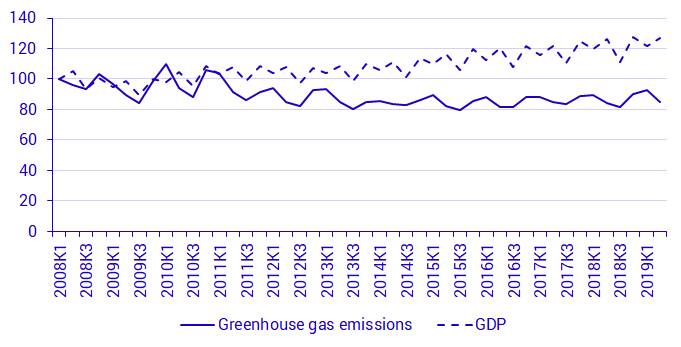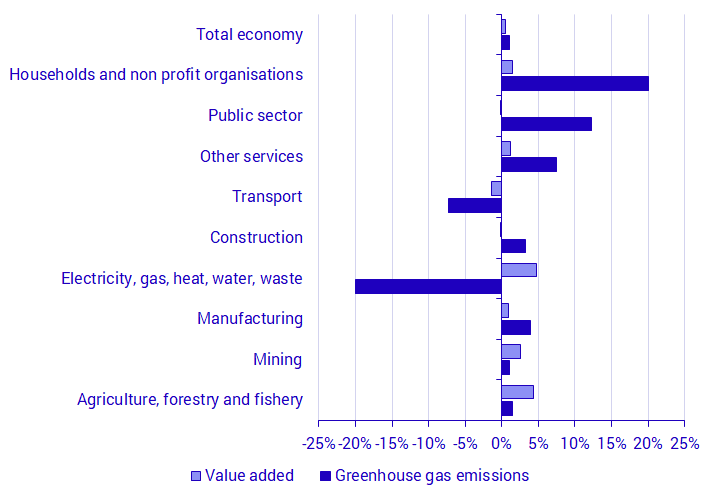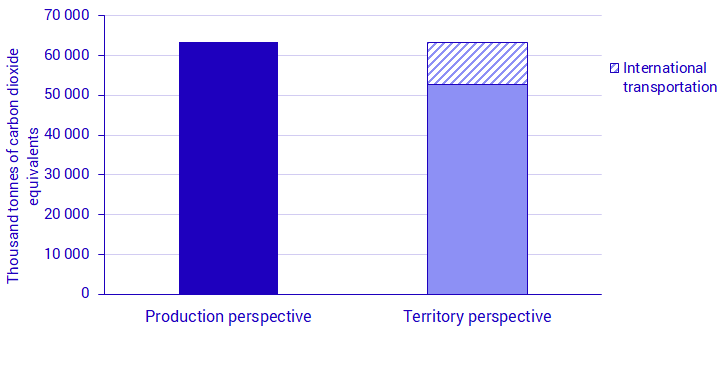Environmental Accounts – Emissions to air Q2 2019
Greenhouse gas emissions from the Swedish economy increased in the second quarter of 2019
Statistical news from Statistics Sweden 2019-10-31 9.30
Greenhouse gas emissions by the Swedish economy increased by 1.1 percent in the second quarter of 2019 compared with the same period in 2018. This increase is largely due to households’ increased fuel demand for private transport. At the same time, GDP increased by 0.6 percent in the second quarter of 2019 compared with the same period the previous year.
New quarterly statistics from the Environmental Accounts at Statistics Sweden measuring emissions from the Swedish economy (including households) are now available.
In the second quarter of 2019, greenhouse gas emissions from the Swedish economy and households amounted to 15.6 million tonnes of carbon dioxide equivalents. This is 1.1 percent more than in the same quarter in 2018. In the same period, Swedish GDP growth was 0.6 percent.

Source: Statistics Sweden
Greenhouse gas emissions from electricity, gas and heat supply and the transport sector are decreasing but are increasing from the manufacturing sector and households
Greenhouse gas emissions from electricity, gas and heat supply fell by 20 percent compared to the same quarter in 2018 due to reduced use of blast furnace gas for electricity production. Emissions from the transport sector decreased by 7.3 percent as a result of diminished emissions in shipping. However, emissions increased by 4 percent in the manufacturing sector due to increased fossil fuel use. Direct emissions from households increased by 20 percent compared to the same quarter in 2018, leading emissions to increase at the national level.
However, these results should be interpreted with caution since the monthly fuel, gas and inventory statistics, which are the basis for transport emissions, have been revised, thereby introducing new uncertainties in the statistics. More information on the survey on monthly fuel, gas and inventory statistics is available here:

Source: Statistics Sweden
| NACE 2007 industry | Greenhouse gas emissions | Value Added | |||||
|---|---|---|---|---|---|---|---|
| 2019Q2 | Change compared to same quarter 2018 | 2019Q2 | Change compared to same quarter 2018 | ||||
| Agriculture, forestry and fishery | 2 369 | 36 | 1.5% | 18 837 | 793 | 4.4% | |
| Mining | 274 | 3 | 1.0% | 6 315 | 160 | 2.6% | |
| Manufacturing | 3 979 | 153 | 4.0% | 163 375 | 1 393 | 0.9% | |
| Electricity, gas, heat, water, waste | 1 359 | ‑340 | ‑20.0% | 32 948 | 1 496 | 4.8% | |
| Construction | 526 | 17 | 3.3% | 84 847 | ‑105 | ‑0.1% | |
| Transport | 3 196 | ‑253 | ‑7.3% | 44 879 | ‑645 | ‑1.4% | |
| Other services | 936 | 65 | 7.4% | 530 551 | 6 146 | 1.2% | |
| Public sector | 195 | 21 | 12.3% | 224 516 | ‑294 | ‑0.1% | |
| Households and non-profit institutions [1] | 2 795 | 466 | 20% | 15 108 | 215 | 1.4% | |
| Total economy | 15 627 | 167 | 1.1% | 1 264 304 | 7 132 | 0.6% | |
[1] Only non-profit institutions provide value added. Source: Statistics Sweden
Statistics from the Swedish Environmental Protection Agency
The Swedish Environmental Protection Agency also publishes quarterly statistics on air emissions within the territory of Sweden, in which emissions from international transport are not included. The results show that emissions calculated in this way increased by 3.4 percent in the second quarter of 2019 compared with the same quarter in 2018.
Revisions
The survey conducted by the Swedish Energy Agency on monthly fuel, gas and inventory statistics has been conducted for several years. The environmental accounts calculations for quarterly air emissions has used these statistics as input data to estimate emissions from mobile sources. In 2018, the Swedish Energy Agency updated and developed the monthly energy statistics survey, which resulted in some uncertainties. This led the environmental accounts to use a different method for a period. However, starting with the publication of the statistical news in August 2019, the environmental accounts returned to the earlier method of using the monthly fuel, gas and inventory statistics to estimate emissions from mobile combustion.
Activities are currently underway to improve these statistics, and revisions are expected during 2019. This will also lead to revisions of the emissions statistics for 2018Q1-2019Q2. This uncertainty affects mobile combustion, which accounts for about 45 percent of greenhouse gas emissions. For this reason, there is also a time series break in the yearly data between 2018 and 2017. One particularly complex area of measurement is fuel demand in international shipping and aviation.
More information (in Swedish) on the revisions is available on the Environmental Accounts’ product page under Documentation.
Definitions and explanations
Frequently asked questions – climate change statistics
Statistics Sweden and the Swedish Environmental Protection Agency are now publishing statistics about air emissions in the second quarter of 2019.
The statistics presented by Statistics Sweden and the Swedish Environmental Protection Agency differ. Below are answers to some frequently asked questions, such as why the statistics differ and how they can be used.
What are the statistics about?
These statistics cover emissions of greenhouse gases and air pollution.
The Swedish Environmental Protection Agency is responsible for statistics on emissions in the territory of Sweden, also called territorial statistics, while Statistics Sweden is responsible for statistics on emissions from an economic perspective, as a part of the System of Environmental Economic Accounting. Both of these statistical products are classified as official statistics, which means that they follow guidelines on when and how the statistics are to be published, how the quality is to be assured and how the statistics are documented.
Are there differences in the statistics – and if so, why?
The System of Environmental-Economic Accounting (SEEA) is constructed with the national accounts as a foundation, and presents environmental and economic statistics in a common system. The point of departure is Swedish economic actors, regardless of where in the world their environmental impact occurs. As the focus is on economic actors, activities such as international transport are included in the same way as in economic statistics. As such, SEEA statistics typically show larger emissions levels than territorial emissions.
Territorial statistics on greenhouse gas emissions show territorial emissions, that is, emissions that occur within Sweden’s borders.
This often leads to different levels in these two statistical products (see an example from 2017 below). Sometimes the changes between years can also differ.
Comparison of Environmental Accounts data on total production-based emissions and Swedish EPA data on total territory-based emissions, 2017

Source: Statistics Sweden, Environmental Accounts and the Swedish Environmental Protection Agency
Are the differences significant for how the statistics can be used?
Yes, the differences are significant. Territorial statistics show the amount of emissions of climate change gases released within Sweden’s borders, and are used to monitor emissions and compare them to climate change targets in Sweden, the EU and the UN.
The climate change statistics that are reported to the UN show which emissions sources are present in different countries. These countries can apply policy instruments with the aim of reducing emissions that are calculated in this way.
The statistics that are produced in the environmental accounts, on the other hand, can answer questions about how various components of production and consumption contribute to emissions. By linking statistics to industrial sectors and products, the prices of natural resources and the impact intensity of employment can also be analysed.
Why are two different government agencies producing almost identical statistics?
In Sweden, there are 28 government agencies responsible for official statistics within their respective areas. Four of these government agencies are responsible for official statistics in the area of environment. The Swedish Environmental Protection Agency is responsible for official statistics on emissions, waste, implementation of the Environmental Code, and the state of the environment. Meanwhile, Statistics Sweden is responsible for official statistics on environmental accounts, which are based on economic statistics that Statistics Sweden is also responsible for, and sustainable development, which links statistics in a range of areas such as land use, water use, fertilisers and lime.
Why are there two different statistical frameworks on emissions to air and climate?
The two different statistical frameworks for emissions to air and climate answer different questions. Questions about how the economy affects the environment need to be answered using other system boundaries than questions about environmental impacts within a country’s territorial border. These frameworks have been developed by experts who have ensured that the statistics that are produced are globally comparable for the specific purpose they serve. All countries that produce this type of statistics must follow the relevant framework and aim to include the same activities in the statistics to ensure comparability.
For international reporting to the UN Climate Change Convention, guidelines have been developed by the UN Panel on Climate Change: https://www.ipcc.ch/.
For environmental accounts, there is a statistical framework available, developed by the UN Statistical Division. www.seea.un.org/content/seea-central-framework.
Both types of statistical products are reported at the international level to the UN, Eurostat, and the European Environment Agency, in accordance with relevant regulations and conventions.
What are the government agencies doing to cooperate?
To create a consensus on the work being done, the two government agencies develop common documents that describe the statistics. The two agencies also jointly take part in conferences and other forums to inform about current efforts. In a podcast hosted by Statistics Sweden, representatives of the two agencies discuss climate change statistics (in Swedish): På tal om siffror - Miljö och klimat.
The most extensive cooperation is carried out under the auspices of the Swedish Environmental Emissions Data consortium (SMED), in which Statistics Sweden is a major partner and for whom the Swedish EPA is the principal client. In particular, SMED produces the annual and quarterly territorial statistics on behalf of the Swedish EPA. The production of quarterly statistics is carried out in close cooperation with the environmental accounts team, which has developed an efficient system for producing quarterly statistics on both the economy and the territory of Sweden. This cooperation includes an exchange of data and knowledge between the agencies.
To find out more about the differences in the statistics, read more here (in Swedish):
About the territorial statistics:
Kvartals- och preliminära årsvisa växthusgasutsläpp
About the environmental accounts calculations for emissions to air and climate change:
Kvalitetsdeklaration: Miljöräkenskaperna – Utsläpp till luft per kvartal, 2008-2018 (pdf)
A joint description of the statistics:
Next publishing will be
The next statistical news, on quarterly emissions to air in the third quarter 2019, is scheduled for publication on 2020-01-30 at 09.30.
Statistical Database
More information is available in the Statistical Database
Feel free to use the facts from this statistical news but remember to state Source: Statistics Sweden.
